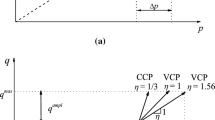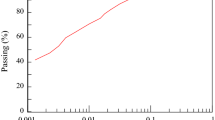Abstract
It is important to be fully aware of the dynamic characteristics of saturated soft clays under complex loading conditions in practice. In this paper, a series of undrained tests for soft clay consolidated with different initial major principal stress direction ξ were conducted by a hollow cylinder apparatus (HCA). The clay samples were subjected to pure principal stress rotation as the magnitudes of the mean total stress p, intermediate principal stress coefficient b, and deviator stress q were all maintained constant. The influences of intermediate principal stress coefficient and initial major principal stress direction on the variation of strain components, generation of pore water pressure, cyclic degradation and non-coaxiality were investigated. The experimental observations indicated that the strain components of specimen were affected by both intermediate principal stress coefficient and initial major principal stress direction. The generation of the pore water pressure was significantly influenced by intermediate principal stress coefficient. However, the generation of pore water pressure was merely influenced by initial major principal stress direction when b = 0.5. It was also noted that the torsional stress–strain relationships were affected by the number of cycles, and the effect of intermediate principal stress coefficient and initial major principal stress direction on the torsional stress–strain loops were also significant. Stiffness degradation occur under pure principal stress rotation. Anisotropic behavior resulting from the process of inclined consolidation have considerable effects on the strain components and non-coaxial behavior of soft clay.


























Similar content being viewed by others
References
Gutierrez M, Ishihara K, Towhata I (1991) Flow theory for sand during rotation of principal stress direction. Soils Found 31:121–132
Hight DW, Gens A, Symes MJ (1983) The development of a new hollow cylinder apparatus for investigating the effects of principal stress rotation in soils. Géotechnique 33(4):355–383
Ishihara K, Towhata I (1983) Sand response to cyclic rotation of principal stress directions as induced by wave loads. Soils Found 23(4):11–26
Jardine RJ, Smith PR (1991) Evaluating design parameters for multi-stage construction. In: Proceedings of international conference on geotechnical engineering for coastal development, Yokosuka, pp 197–202
Kirkgard MM, Lade PV (1993) Anisotropic three-dimensional behavior of a normally consolidated clay. Can Geotech J 30(5):848–858
Kumruzzaman M, Yin JH (2010) Influences of principal stress direction and intermediate principal stress on the stress–strain–strength behaviour of completely decomposed granite. Can Geotech J 47(2):164–179
Lade PV, Kirkgard MM (2000) Effects of stress rotation and changes of b-values on cross-anisotropic behavior of natural, K0-consolidated soft clay. Soils Found 40(6):93–105
Miura K, Miura S, Toki S (1986) Deformation behavior of anisotropic dense sand under principal stress rotation. Soils Found 26(1):36–52
Nakata Y, Hyodo M, Murata H, Yasufuku N (1998) Flow deformation of sands subjected to principal stress rotation. Soils Found 38(2):115–128
Nishimura S, Minh N, Jardine R (2007) Shear strength anisotropy of natural London clay. Geotechnique 57(1):49–62
Qian J, Yang J, Huang M (2008) Three-dimensional non-coaxial plasticity modelling of shear band formation in geomaterials. J Geotech Eng ASCE 134(4):322–329
Qian J-g, You Z, Huang M, Gu X (2013) A micromechanics-based model for estimating localized failure with effects of fabric anisotropy. Comput Geotech 50:90–100
Qian J, Wang Y-G, Yin Z-Y, Huang M-S (2016) Experimental identification of plastic shakedown behavior of saturated clay subjected to traffic loading with principal stress rotation. Eng Geol 214:29–42
Qian JG, Du ZB, Yin ZY (2017) Cyclic degradation and non-coaxiality of soft clay subjected to pure rotation of principal stress directions. Acta Geotech 2018(13):943–959
Shen Y, Zhou J, Gong XN, Liu HL (2008) Intact soft clay’s critical response to dynamic stress paths on different combinations of principal stress orientation. J Cent South Univ Technol 15:147–154
Shibuya S, Hight DW, Symes MJ (1984) Discussion on the paper by Ishihara and Towhata (1983). Soils Found 24(3):107–110
Symes MJ, Gens A, Hight DW (1984) Undrained anisotropy and principal stress rotation in saturated sand. Géotechnique 34(1):11–27
Symes MJ, Gens A, Hight DW (1988) Drained principal stress rotation in saturated sand. Géotechnique 38(1):59–81
Tong ZX, Zhang JM, Yu YL, Zhang G (2010) Drained deformation behavior of anisotropic sands during cyclic rotation of principal stress axes. J Geotech Geoenviron Eng 136(11):1509–1518
Wang YK, Guo L, Gao YF, Qiu Y, Hu XQ, Zhang Y (2016) Anisotropic drained deformation behavior and shear strength of natural soft marine clay. Mar Georesour Geotechnol 34(5):493–502
Wang Y, Gao Y, Guo L, Cai Y, Li B, Qiu Y, Mahfouz AH (2017) Cyclic response of natural soft marine clay under principal stress rotation as induced by wave loads. Ocean Eng 129:191–202
Wang Y, Gao Y, Li B, Fang H, Wang F, Guo L, Zhang F (2017) One-way cyclic deformation behavior of natural soft clay under continuous principal stress rotation. Soils Found 57(6):1002–1013
Wang Z, Yang Y, Yu H-S (2017) Effects of principal stress rotation on the wave–seabed interactions. Acta Geotech 12:97–106
Wang Y, Gao Y, Guo L, Yang Z (2018) Influence of intermediate principal stress and principal stress direction on drained behavior of natural soft clay. Int J Geomech 18(1):04017128
Wang Y, Gao Y, Cai Y, Guo L (2018) Effect of initial state and intermediate principal stress on non-coaxiality of soft clay involved cyclic principal stress rotation. ASCE Int J Geomech 18(7):04018081
Xiong H, Guo L, Cai Y, Yang Z (2016) Experimental study of drained anisotropy of granular soils involving rotation of principal stress direction. Eur J Environ Civ Eng 20(4):431–454
Yang Y, Yu HS (2006) A non-coaxial critical state soil model and its application to simple shear simulations. Int J Numer Anal Meth Geomech 30(13):1369–1390
Yang ZX, Li XS, Yang J (2007) Undrained anisotropy and rotational shear in granular soil. Géotechnique 57(4):371–384
Zdravković L, Jardine RJ (2001) The effect on anisotropy of rotating the principal stress axes during consolidation. Géotechnique 51(1):69–83
Zhou J, Xu CJ (2014) Impact of shear stress on strain and pore water pressure behavior of intact soft clay under principal stress rotation. Geotech Test J 37(3):1–16. https://doi.org/10.1520/GTJ20120189
Zhou J, Yan J, Xu C, Gong X (2013) Influence of intermediate principal stress on undrained behavior of intact clay under pure principal stress rotation. Math Probl Eng 950143:1–10
Acknowledgements
This work present in this paper was supported by the National Key Research and Development Program of China (Grant No. 2016YC0800205); National Natural Science Foundation of China (Grant No. 51639002); “111” Project under No. B13024; Key Laboratory of Ministry of Education for Geomechanics and Embankment Engineering, Hohai University; China Postdoctoral Science Foundation (2017M610461). This financial support is gratefully acknowledged.
Author information
Authors and Affiliations
Corresponding author
Additional information
Publisher's Note
Springer Nature remains neutral with regard to jurisdictional claims in published maps and institutional affiliations.
Rights and permissions
About this article
Cite this article
Wang, Y., Gao, Y., Li, B. et al. Influence of initial state and intermediate principal stress on undrained behavior of soft clay during pure principal stress rotation. Acta Geotech. 14, 1379–1401 (2019). https://doi.org/10.1007/s11440-018-0735-5
Received:
Accepted:
Published:
Issue Date:
DOI: https://doi.org/10.1007/s11440-018-0735-5




